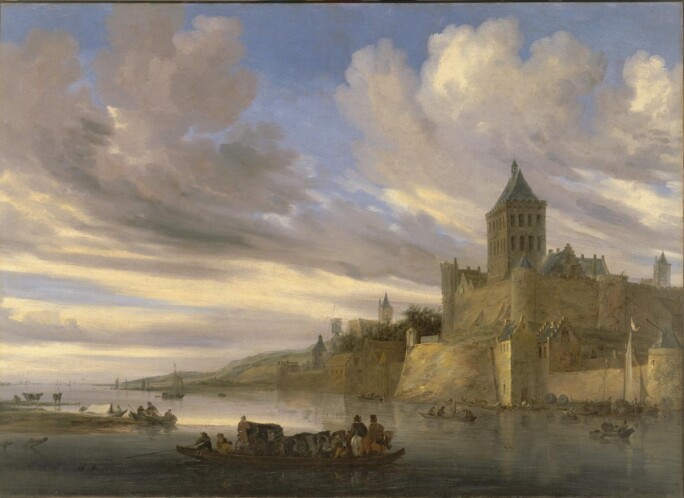“…Ruysdael’s charm is undeniable, and the calm lyricism as well as the pictorial subtlety of his river scenes are not easily forgotten."
T he grand scale, visual lyricism, and exceptional condition of this painting secure it as one of Salomon van Ruysdael’s finest works. Showcasing Ruysdael’s singular ability to evoke atmosphere with a masterfully harmonious effect, this is undoubtedly the most significant work by the Dutch artist to appear on the market in modern memory. Painted in 1652—four years after the signing of the Treaty of Münster ended the Eighty Years War and secured lasting independence and peace for the Dutch people—this work stands as a testament to the prosperity of the Dutch Republic. Here, Ruysdael captures a serene view of the Valkhof in Nijmegen, a fortress of great historical significance in the Netherlands, and imbues the scene with a captivating sense of timelessness. In every sense of the word, this panel exemplifies the height of Ruysdael’s career as well as the seventeenth-century Dutch landscape tradition.
Salomon van Ruysdael was born in Naarden in about 1600-1603 to the carpenter Jacob de Goyer. Like his brother (Isaac van Ruisdael), son (Jacob Salomonsz. van Ruysdael), and nephew (Jacob van Ruisdael), Salomon van Ruysdael specialized in landscape painting.2 As a young man, Salomon moved to Haarlem, where he joined the painter’s guild in 1623 and where he remained active for most of his career. Although details of his artistic training remain uncertain, his early works reveal the influence of Pieter Molyn and Esaias van de Velde, under whom he may have trained. During the late 1620s and 1630s, Ruysdael, like his contemporary Jan van Goyen, embraced the tonal school of landscape painting—favoring softened atmospheric effects and a restrained palette. By the 1640s, his style evolved considerably. He incorporated a more vibrant color scheme with subtle yet varied hues and expansive waterways and vast skies filled with billowing clouds became defining elements of his work. After 1650, his tones brightened even further, and the present painting exemplifies the pinnacle of his mature career.

A soft, warm light bathes this expansive and tranquil scene. Billowing clouds drift across the vast sky above the river Waal on a particularly peaceful day. Various vessels—rowboats, sailboats, and a ferry laden with cattle, two of which lean over the edge to drink—glide along the gently rippled water, stirred by a light breeze and the sounding of the trumpet of the man on the ferry wearing a brilliant red sash. The river extends into the distance on the left, its banks quietly animated by ports, buildings, and animals. On the right, the Valkhof rises from its ancient foundations, its distinctive façade reflected in the river below. In the sky—a brilliant expanse of blue enriched with delicate hues of lavender, pink, and gold—Ruysdael captures the fleeting shifts of light on a crisp, clear day. His confident brushstrokes, visible in passages of well-preserve impasto, lend depth and texture to the surface of this large panel. His meticulous rendering of architecture, boats, figures, and animals showcases his mastery in blending naturalism with his distinct artistic sensibility.
After Dordrecht, Nijmegen was the second major city encountered when travelling from the North Sea up the river Waal, one of the two principal trade routes on the Rhine that connected the Netherlands and Germany. Towering over a bend in the river, the city was home to the Valkholf, a fortress built by Charlemagne atop ancient Roman ruins with its imposing keep rising above fortified walls. In Ruysdael’s time, Nijmegen held considerable patriotic significance to the newly formed Dutch Republic. The city had once been the stronghold of Gaius Julius Civilis, leader of the Batavians, who launched a successful revolt against the Roman Empire in 69 CE. The Batavians, regarded as the forebears of the emerging Dutch Republic, became a symbol of resistance, one that mirrored the Dutch struggle for independence from Spanish rule.

Right: Fig. 2 Albert Cuyp, The Valkhof at Nijmegen, oil on panel, 19 ¼ by 29 in. (48.9 by 73.7 cm). Indianapolis Museum of Art, inv. no. 43.107.
Nijmegen and its hilltop silhouette would have left a lasting impression on a Dutch population largely unaccustomed to elevations higher than a sand dune, and its striking rise above the river Waal captivated the imagination of many seventeenth-century Dutch artists. Among them, Jan van Goyen painted the view on a number of occasions, including a large 1641 canvas (fig. 1) that records a similar view as the present work, albeit with a more restrained tonal range. In about 1652-1654, Albert Cuyp captured Nijmegen from a slightly different angle (fig. 2), suffusing the scene with golden light and populating the foreground with figures and cattle.

Although it remains uncertain whether Salomon van Ruysdael ever traveled to Nijmegen, the city clearly fascinated him, and he explored it with his brush on both canvas and panel. An earlier panel by Ruysdael from 1647 last appeared at auction at Sotheby’s London in 2013,3 while a smaller view on canvas from 1648, formerly in the Kress Collection, is today at the Legion of Honor in San Francisco (fig. 3). Additionally, a larger canvas, signed and indistinctly dated 165[…], last appeared at auction at Christie’s New York on 24 January 2003.4 In the present example, Ruysdael elevates the hilltop city to an emblematic status, capturing both its historical importance and its beauty.
1 S. Slive, in The Pelican History of Art: Dutch Art and Architecture 1600-1800, vol. XXVII, Baltimore 1966, p. 151.
2 Salomon and his brother Isaac seemed to have adopted the surname Ruysdael (Ruisdael), perhaps after a small town near Blaricum, the birthplace of their father, or after Castle Ruisschendael. See W. Liedtke, Dutch Paintings in the Metropolitan Museum of Art, New York 2007, vol. II, p. 801.
3 Anonymous sale (“The Property of a Private Collector”), London, Sotheby’s, 13 July 2003, lot 15.
4 Offered anonymously (“The Property of an American Corporation”), New York, Christie’s, 24 January 2003, lot 16, where unsold.